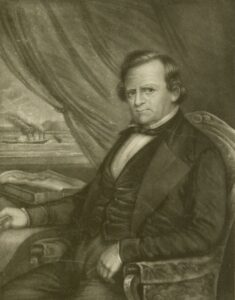Henry Miller Shreve
Henry Miller Shreve—the namesake of Shreveport—is most remembered for removing the Red River Raft.

Missouri Historical Society
Engraved portrait of Henry Miller Shreve by Samuel Treat published in 1848.
Henry Miller Shreve—for whom Shreveport is named—is most remembered for removing the Great Raft, a 150-mile logjam that obstructed safe navigation of the Red River above Natchitoches.
Early Life
Although the city of Shreveport bears his name, Shreve was born in western Pennsylvania in 1785. He grew up near the banks of the Monongahela River and began his career as a boatman in 1802 at seventeen. Within a decade he captained his own barges and keelboats along the Ohio and Mississippi Rivers. In January 1815 he entered the public spotlight after the Monongahela and Ohio Steam Boat Company appointed him to captain their new ship, the Enterprise, on a voyage from Pittsburgh to New Orleans to deliver weapons to American forces defending the city from the British during the War of 1812.
When he arrived in New Orleans, Shreve was arrested for violating a monopoly on steamboat traffic that the Louisiana State Legislature granted a year earlier to New York’s Livingston-Fulton Company, one of the Pennsylvania group’s competitors. However, Shreve was released, the case dismissed by the local court, and the entire monopoly was deemed unconstitutional by the US Supreme Court as a violation of federal authority over interstate commerce in the 1824 case Gibbons v. Ogden.
Clearing the Great Raft
The defining accomplishment of Shreve’s career was the clearing of the Red River logjam known as the Great Raft. Shreve completed this work between 1832 and 1838 while employed in federal service as the US Superintendent of Western Rivers. The project’s success relied on “snag boats” that Shreve first invented in 1829. Snag boats are steam-powered, double-hulled ships equipped with a bow-mounted lifting apparatus for removing logs and other debris from riverbeds. Over the next decade, as steamboat traffic expanded rapidly along the Mississippi River and its tributaries, Shreve’s snag boats became essential tools in federal efforts to open the Red River and maintain safe channels for river commerce across the nation.
Clearing the Great Raft was impossible until the arrival of Shreve’s snag boats. The obstructions that created the Great Raft were large bottomland trees that had been undermined and washed away when seasonal floods eroded the riverbanks underneath them. These trees could weigh up to seventy-five tons, and when they sank in contorted angles into the soft riverbed, they dammed the flow of other logs and debris. Over centuries they transformed the flowing river into a stagnant maze of forested marshes and bayous.
By the early 1820s, efforts to remove these kinds of snags from the riverbed had already benefited from the relatively new application of steam power. By connecting two parallel steamboats with a perpendicular central crossbeam, river pilots could drive up onto the snag and apply the crossbeam as a crude lever. However, Shreve’s innovations applied in his first snag boat, the Heliopolis, were twofold. First, he permanently joined the two steamboat hulls at the bow and stern to add rigidity. Second, he built a transmission that geared the ship’s engine to a lever on the bow that used steam power and mechanical advantage to lift the snag. These innovations made Shreve’s invention remarkably efficient. His Ohio-based crews broke up more than forty miles of the Great Raft in just their first season on the job.
Shreve Town Company and Later Life
The origins of Shreveport are traced to the Shreve Town Company, a business in which Shreve was among the investors. He liquidated his investments in the city after he was relieved from federal service in 1841 during a new wave of political appointments following President William Henry Harrison’s inauguration. Shreve retired in St. Louis, Missouri, where he spent the rest of his public life petitioning Congress to pay him back-licensing fees for using his snag boats in the decade before he patented the invention. Congress settled the claims with Shreve’s estate in 1880, nearly thirty years after his death in 1851, an eventual recognition of the significance of Shreve’s inventions for American river navigation.
